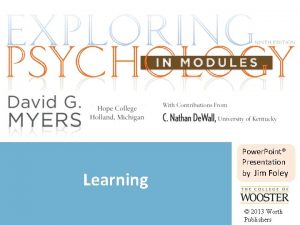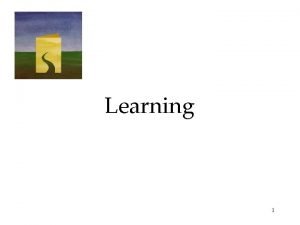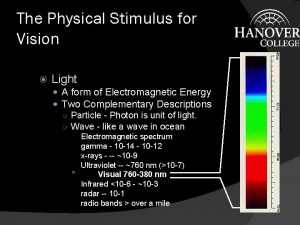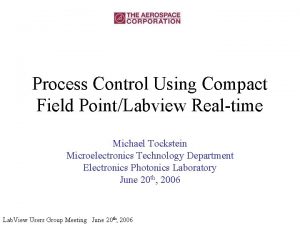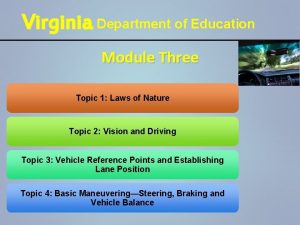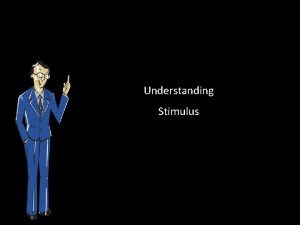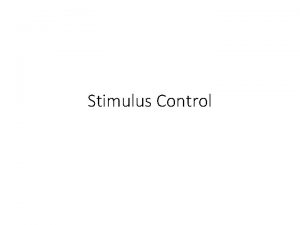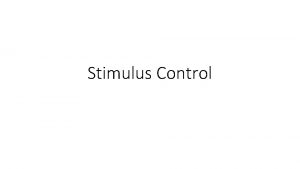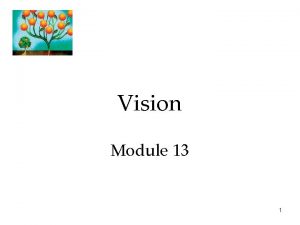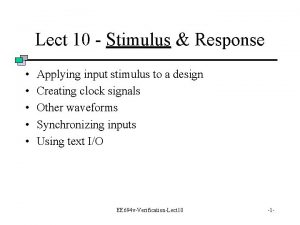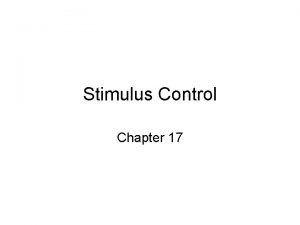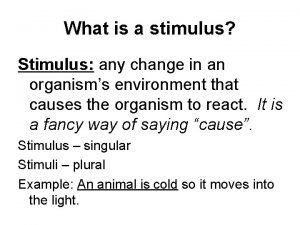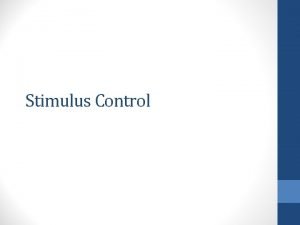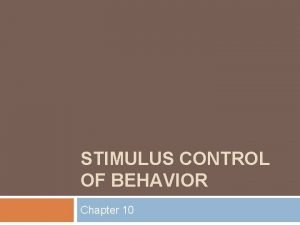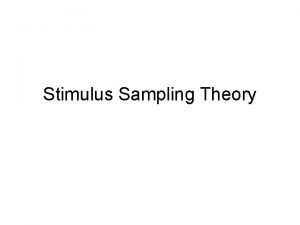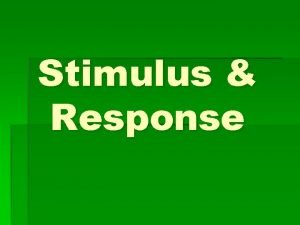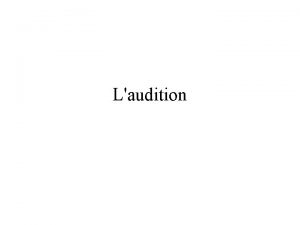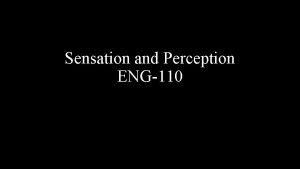Vision Module 13 1 Vision The Stimulus Input























































- Slides: 55

Vision Module 13 1

Vision § The Stimulus Input: Light Energy § The Eye § Visual Information Processing § Color Vision 2

Transduction Conversion of one form of energy to another. How is this important when studying sensation? Stimulus energies to neural impulses. For example: Light energy to vision. Chemical energy to smell and taste. Sound waves to sound. 3

Vision 4

Both Photos: Thomas Eisner The Stimulus Input: Light Energy Visible Spectrum 5

What makes up a light wave? 6

Light Characteristics 1. Wavelength (hue/color) 2. Intensity (brightness) 3. Saturation (purity) 7

Wavelength (Hue) Hue (color): dimension of color determined by wavelength of light. Wavelength the distance from the peak of one wave to the peak of the next. 8

Wavelength (Hue) Violet Indigo 400 nm Short wavelengths Blue Green Yellow Orange Red 700 nm Long wavelengths Different wavelengths of light result in different colors. 9

Intensity (Brightness) Intensity Amount of energy in a wave determined by amplitude; related to perceived brightness. 10

Intensity (Brightness) Blue color with varying levels of intensity. As intensity increases or decreases, blue color looks more “washed out” or “darkened. ” 11

Purity (Saturation) Saturated Monochromatic light added to green and red make them less saturated. 12

Color Solid Represents all three characteristics of light stimulus on this model. http: //www. visionconnection. org 13

The Eye 14

• • • Cornea Pupil/Iris Lens: accommodation Retina/rods and cones (fovea) Bipolar cells -> ganglion cells Optic nerves Where they cross is the optic chiasm Thalamus Occipital lobe 15

Fig. 5. 4 The human eye, a simplified view. Table of Contents 16 Exit

Fig. 5. 6 The iris and diaphragm. Table of Contents 17 Exit

Parts of the eye 1. Cornea: Transparent tissue where light enters the eye. 2. Iris: Muscle that expands and contracts to change the size of opening (pupil) for light. 3. Lens: Focuses the light rays on the retina. Accommodation 4. Retina: Contains sensory receptors that process visual information and send it to the brain. 18

Light Control (cont. ) • Visual Acuity: Sharpness of visual perception • Fovea: Area of the retina containing only cones • Peripheral Vision: Vision at edges of visual field; side vision – Many superstar athletes have excellent peripheral vision • Tunnel Vision: Loss of peripheral vision Table of Contents 19 Exit

Light Control • Cones: Visual receptors for colors and bright light (daylight) Fine detail vision • Rods: Visual receptors for dim light; only produce black and white • Blind Spot: Area of the retina lacking visual receptors Table of Contents 20 Exit

The Lens: Transparent structure behind pupil that changes shape to focus images on the retina. Accommodation: The process by which the eye’s lens changes shape to help focus near or far objects on the retina. 21

The Lens Nearsightedness: A condition in which nearby objects are seen more clearly than distant objects. Farsightedness: A condition in which faraway objects are seen more clearly than near objects. 22

23

Nearsighted Vision 24

Farsighted Vision 25

Retina: The lightsensitive inner surface of the eye, containing receptor rods and cones plus layers of other neurons (bipolar, ganglion cells) that process visual information. 26

Optic Nerve, Blind Spot & Fovea Optic nerve: Carries neural impulses from the eye to the brain. Blind Spot: Point where optic nerve leaves the eye, because there are no receptor cells located here, it creates a blind spot. Fovea: Central point in the retina, around which the eye’s cones cluster. http: //www. bergen. org 27

28

Photoreceptors E. R. Lewis, Y. Y. Zeevi, F. S Werblin, 1969 29

Bipolar & Ganglion Cells Bipolar cells receive messages from photoreceptors and transmit them to ganglion cells, which form the optic nerve. 30

Visual Information Processing Optic nerves connect to the thalamus in the middle of the brain, and the thalamus to the visual cortex. 31

Ganglion & Thalamic Cells Retinal ganglion cells and thalamic neurons break down visual stimuli into small components and have receptive fields with center-surround organization. ON-center OFF-Surround Action Potentials 32

Feature Detection Ross Kinnaird/ Allsport/ Getty Images Nerve cells in the visual cortex respond to specific features, like edges, angle, and movement. 33

Shape Detection Ishai, Ungerleider, Martin and Haxby/ NIMH Specific combinations of temporal lobe activity occur as people look at shoes, faces, chairs and houses. 34

Perception in Brain Our perceptions are a combination of sensory (bottom-up) and cognitive (top-down) processes. 35

Visual Information Processing of several aspects of the stimulus simultaneously is called parallel processing. The brain divides a visual scene into subdivisions such as color, depth, form and movement etc. 36

Parallel Processing • The processing of several aspects of a problem simultaneously. Color Motion Form Depth 37

How do we see in color? What color is this dragon? 38

Color • The dragon is anything but red. • The dragon rejects the long wavelengths of light that to us are red - so red is reflected of and we see it. • Also, light has no real color. • It is our mind that perceives the color. 39

Tim Bieber/ The Image Bank From Sensation to Recognition 40

Color Vision • Trichromatic Theory: Color vision theory that states we have three cone types: red, green, blue – Other colors produced by a combination of these – Black and white produced by rods • Opponent Process Theory: Color vision theory based on three “systems”: red or green, blue or yellow, black or white – Exciting one color in a pair (red) blocks the excitation in the other member of the pair (green) – Afterimage: Visual sensation that remains after stimulus is removed (seeing flashbulb after the picture has been taken) Table of Contents 41 Exit

Young-Helmholtz Trichromatic (three color) Theory • Realized that any color can be created by combining the light waves of three primary color • So they guessed that we have 3 different types of receptor cells in our eyes. Together they can pick any combination of our 7 million color variations. • Most colorblind people simply lack cone receptor cells for one or more of these primary colors. 42

Subtraction of Colors If three primary colors (pigments) are mixed it results in subtraction of all wavelengths and the result is a black color. 43

Addition of Colors If three primary colors (lights) are mixed the wavelengths are added and they result in white color. Fritz Goro, LIFE magazine, © 1971 Time Warner, Inc. 44

Photoreceptors Mac. Nichol, Wald and Brown (1967) measured directly the absorption spectra of visual pigments of single cones obtained from the retinas of humans. Blue Cones Short wave Green Cones Medium wave Red Cones Long wave 45

Color Blindness • Inability to perceive colors; lacks cones or has malfunctioning cones – Total color blindness is rare • Color Weakness: Inability to distinguish some colors – Red-green is most common; much more common among men than women – Recessive, sex-linked trait on X chromosome • Ishihara Test: Test for color blindness and color weakness Table of Contents 46 Exit

Color Blindness Genetic disorder in which people are blind to green or red colors supports Trichromatic theory. Ishihara Test 47

Fig. 5. 15 Color blindness and color weakness. (a) Photograph illustrates normal color vision. (b) Photograph is printed in blue and yellow and gives an impression of what a red-green color-blind person sees. (c) Photograph simulates total color blindness. If you are totally colorblind, all three photos will look nearly identical. Table of Contents 48 Exit

Dark Adaptation • Increased retinal sensitivity to light after entering the dark; similar to going from daylight into a dark movie theater • Rhodopsin: Light-sensitive pigment in the rods; involved with night vision • Night Blindness: Blindness under low-light conditions; hazardous for driving at night Table of Contents 49 Exit

Opponent Process Theory Hering, proposed that we process four primary colors opposed in pairs of red-green, blue-yellow, and black-white. Cones Retinal Ganglion Cells 50

Fig. 5. 11 Negative afterimages. Stare at the dot near the middle of the flag for at least 30 seconds. Then look immediately at a plain sheet of white paper or a white wall. You will see the American flag in its normal colors. Reduced sensitivity to yellow, green, and black in the visual system, caused by prolonged staring, results in the appearance of complementary colors. Project the afterimage of the flag on other colored surfaces to get additional effects. Table of Contents 51 Exit

Fig. 5. 12 Firing rates of blue, green, and red cones in response to different colors. The taller the colored bar, the higher the firing rates for that type of cone. As you can see, color sensations are coded by activity in all three types of cones in the normal eye. (Adapted from Goldstein, 1999. ) Table of Contents 52 Exit

Opponent-Process Theory • We cannot see certain colors together in combination (red-green, blue-yellow, and white-black). These are antagonist/ opponent colors. Tube and marble example. 53

54

Color Constancy Color of an object remains the same under different illuminations. However, when context changes color of an object may look different. R. Beau Lotto at University College, London 55
 Associative learning
Associative learning Learned helplessness ap psychology definition
Learned helplessness ap psychology definition Learning is relatively permanent.
Learning is relatively permanent. Stimulus of vision
Stimulus of vision Vision stimulus
Vision stimulus C device module module 1
C device module module 1 Plc
Plc Input output
Input output Backplane for compact fieldpoint
Backplane for compact fieldpoint Finely tuned input
Finely tuned input Perangkat output komputer
Perangkat output komputer Module 3: topic 1 laws of nature
Module 3: topic 1 laws of nature Curriculum guide for driver education in virginia module 3
Curriculum guide for driver education in virginia module 3 Vision input devices
Vision input devices Input and output devices notes
Input and output devices notes Cong thức tính động năng
Cong thức tính động năng Tỉ lệ cơ thể trẻ em
Tỉ lệ cơ thể trẻ em Thế nào là mạng điện lắp đặt kiểu nổi
Thế nào là mạng điện lắp đặt kiểu nổi Lời thề hippocrates
Lời thề hippocrates Vẽ hình chiếu đứng bằng cạnh của vật thể
Vẽ hình chiếu đứng bằng cạnh của vật thể Quá trình desamine hóa có thể tạo ra
Quá trình desamine hóa có thể tạo ra Phản ứng thế ankan
Phản ứng thế ankan Kể tên các môn thể thao
Kể tên các môn thể thao Sự nuôi và dạy con của hổ
Sự nuôi và dạy con của hổ Hình ảnh bộ gõ cơ thể búng tay
Hình ảnh bộ gõ cơ thể búng tay Dạng đột biến một nhiễm là
Dạng đột biến một nhiễm là điện thế nghỉ
điện thế nghỉ Biện pháp chống mỏi cơ
Biện pháp chống mỏi cơ Trời xanh đây là của chúng ta thể thơ
Trời xanh đây là của chúng ta thể thơ Voi kéo gỗ như thế nào
Voi kéo gỗ như thế nào Thiếu nhi thế giới liên hoan
Thiếu nhi thế giới liên hoan Fecboak
Fecboak Một số thể thơ truyền thống
Một số thể thơ truyền thống Thế nào là hệ số cao nhất
Thế nào là hệ số cao nhất Sơ đồ cơ thể người
Sơ đồ cơ thể người Frameset trong html5
Frameset trong html5 Số nguyên là gì
Số nguyên là gì Tư thế ngồi viết
Tư thế ngồi viết đặc điểm cơ thể của người tối cổ
đặc điểm cơ thể của người tối cổ Mật thư tọa độ 5x5
Mật thư tọa độ 5x5 Các châu lục và đại dương trên thế giới
Các châu lục và đại dương trên thế giới Tư thế worm breton
Tư thế worm breton ưu thế lai là gì
ưu thế lai là gì Thẻ vin
Thẻ vin Cái miệng nó xinh thế
Cái miệng nó xinh thế Các châu lục và đại dương trên thế giới
Các châu lục và đại dương trên thế giới Bổ thể
Bổ thể Từ ngữ thể hiện lòng nhân hậu
Từ ngữ thể hiện lòng nhân hậu Tư thế ngồi viết
Tư thế ngồi viết Thế nào là giọng cùng tên? *
Thế nào là giọng cùng tên? * Thơ thất ngôn tứ tuyệt đường luật
Thơ thất ngôn tứ tuyệt đường luật Phép trừ bù
Phép trừ bù Alleluia hat len nguoi oi
Alleluia hat len nguoi oi Hổ sinh sản vào mùa nào
Hổ sinh sản vào mùa nào đại từ thay thế
đại từ thay thế Diễn thế sinh thái là
Diễn thế sinh thái là
